
The Monster
Behind the Scenes
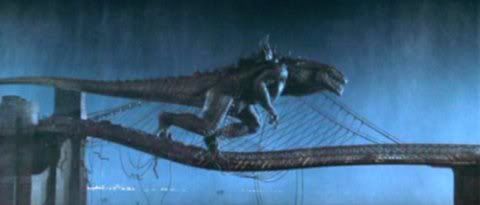 “I think that when the real fans see this movie, they’re going to realize that, yes, this is not like the twenty-two sequels, but it is, very much, in the spirit of the first Godzilla movie. And in essence, we feel it’s more respectful to have a new creature, than to mess around with the old one,” Producer Dean Devlin once explained in an interview. It seems like a contradiction in terms, but I sort of understand where he’s coming from.
“I think that when the real fans see this movie, they’re going to realize that, yes, this is not like the twenty-two sequels, but it is, very much, in the spirit of the first Godzilla movie. And in essence, we feel it’s more respectful to have a new creature, than to mess around with the old one,” Producer Dean Devlin once explained in an interview. It seems like a contradiction in terms, but I sort of understand where he’s coming from.
You can see, just from reading the comments left behind on various blogs, and news sites, even in regards to the Godzilla T-shirt being passed out by Legendary at Comic Con, that whenever you make changes to the original Godzilla, there are going to be things that fans get upset about. I guess that the producers were shooting for a design which would draw no comparison, and in that regard they receive an “A.”
The true star of Godzilla, the monster, was the brain child of creature designer, Patrick Tatopoulos. The creature is indeed far from an accurate mimic of any previous incarnation. Beyond the dorsal plates, and humanoid forelimbs, the 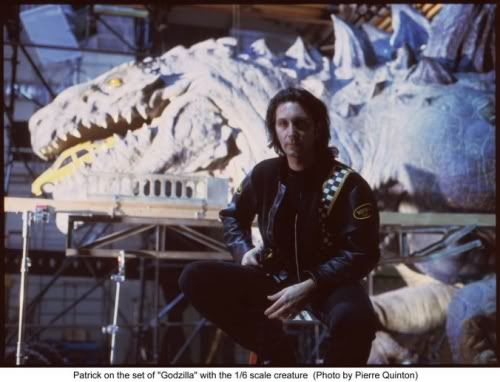 redesign was entirely Tatopoulos’s creation. The end result is a design which is both interesting, and bizarre. However, several sources indicate that at some point in the production, even more bizarre design attributes were being considered. The Godzilla of the 1998 film was meant to be a mutation of a lizard, with primary inspiration seemingly derived from marine iguanas. However, as is emphasized in Stephen Molstad’s book, Godzilla was meant to be a combination of various traits from various reptiles. The monster’s nest of far too many to count was based off of the egg clutches of crocodiles. In several interviews, including the commentary of the DVD tracks, it was mentioned that Godzilla was at one time planned to have the ability to alter its own color, like a chameleon (which could've inspired The Chameleon of Godzilla: the Series). In the children’s book based on the script Godzilla is even described as having a long, prehensile tongue. And while from the beginning of the movie’s production the filmmaker’s had wanted a faster monster, the description of Godzilla running on all fours in Molstad’s novel is simply a concept alien to most Godzilla fans (though considering Godzilla’s revamped origins as a lizard mutation, actually makes sense.) You can see parts of the design process here (though I wish earlier designs were available).
redesign was entirely Tatopoulos’s creation. The end result is a design which is both interesting, and bizarre. However, several sources indicate that at some point in the production, even more bizarre design attributes were being considered. The Godzilla of the 1998 film was meant to be a mutation of a lizard, with primary inspiration seemingly derived from marine iguanas. However, as is emphasized in Stephen Molstad’s book, Godzilla was meant to be a combination of various traits from various reptiles. The monster’s nest of far too many to count was based off of the egg clutches of crocodiles. In several interviews, including the commentary of the DVD tracks, it was mentioned that Godzilla was at one time planned to have the ability to alter its own color, like a chameleon (which could've inspired The Chameleon of Godzilla: the Series). In the children’s book based on the script Godzilla is even described as having a long, prehensile tongue. And while from the beginning of the movie’s production the filmmaker’s had wanted a faster monster, the description of Godzilla running on all fours in Molstad’s novel is simply a concept alien to most Godzilla fans (though considering Godzilla’s revamped origins as a lizard mutation, actually makes sense.) You can see parts of the design process here (though I wish earlier designs were available).
Ultimately, the new Godzilla served as an exciting and refreshing take on the king of monsters, and was interesting if nothing else.
The monster was achieved through use of ground-breaking CGI, or computer generated imagery. In addition, a 1/6 scale animatronic mock-up (as pictured) was used in a number of shots requiring close-ups of the creature's face, and generally adds a material sense to the monster. The infant monsters were achieved through the use of animatronics, the same CGI that gave the big critter life, and robotically assisted creature suits.
The Movie
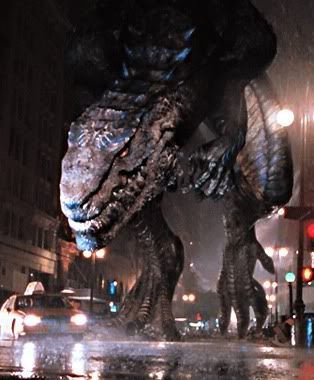 Godzilla in this incarnation shares an all-too familiar origin story with many a monster of the 1950s. Once an ordinary reptile living in the Polynesian , Godzilla’s physiology was altered heavily after its egg was indirectly exposed to the radiation of French nuclear testing. Why the creature wasn’t sighted until some forty years later is unknown. Either it took that long for the animal to reach sexual maturity, or the process of becoming Godzilla escalated from generation to generation.
Godzilla in this incarnation shares an all-too familiar origin story with many a monster of the 1950s. Once an ordinary reptile living in the Polynesian , Godzilla’s physiology was altered heavily after its egg was indirectly exposed to the radiation of French nuclear testing. Why the creature wasn’t sighted until some forty years later is unknown. Either it took that long for the animal to reach sexual maturity, or the process of becoming Godzilla escalated from generation to generation.
Godzilla, upon becoming an adult, then set out northward. It was in this time that serious note was being taken of the creature’s actions, and a team of scientists was dispatched to investigate. The team traced Godzilla to New York City. Once there the monster proceeded to seek out suitable nest space, evict everyone else form its nursery, and out maneuver and even hide from the military, who are faced with negative PR when they loose track of the monster (probably because they weren’t sure what to look for). Dr. Niko Tatopoulos was among the most prolific of the scientists assigned to deal with creature. Tatopoulos suggested the use of bait (which almost succeeded), he found the creature to be pregnant, and he more than anyone seemed to understand the animal’s behavior. Tatopoulos had tried to convince the military to seek out the creature’s nest, however, after footage that had leaked onto the airwaves was traced back to Dr. Tatopoulos, the military refused to listen to the doctor’s insistence. Ultimately, through the combined effort of Dr. Tatopoulos, news reporter Audrey Timmonds, her camera man, and the French secret service, the monster’s nest in Madison Square Garden was destroyed by air strike. Tatopoulos then devised the plan to lure Godzilla onto the Brooklyn Bridge, ensnaring the monster in the suspension cables, immobilizing the animal so that fighter jets could at last have a clear shot at the monster.
The creature stood at a stature of close to 60 meters in height. In spite of its size, the creature was quite agile, capable of weaving in between buildings with staggering efficiency. Should Godzilla have been given enough room, or if properly motivated, the monster could clock in at around 200 miles per hour at full sprint.
 Godzilla displayed a curious demeanor, often stopping to examine more closely anything which garnered its attention. That curiosity fit hand-in-hand with the animal’s high degree of intelligence. The monster was perfectly capable of committing encounters with the military to memory, and as a result could recognize signs of a trap. Godzilla was also notorious for combining its maneuverability with its intelligence, often predicting the course of an enemy, such as a helicopter or a car, to loop around and intercept its target. Godzilla, although not as physically powerful as other mutations, was an enemy to reckon with. Underestimating the monster’s intelligence could’ve meant death, and in many instances, it did.
Godzilla displayed a curious demeanor, often stopping to examine more closely anything which garnered its attention. That curiosity fit hand-in-hand with the animal’s high degree of intelligence. The monster was perfectly capable of committing encounters with the military to memory, and as a result could recognize signs of a trap. Godzilla was also notorious for combining its maneuverability with its intelligence, often predicting the course of an enemy, such as a helicopter or a car, to loop around and intercept its target. Godzilla, although not as physically powerful as other mutations, was an enemy to reckon with. Underestimating the monster’s intelligence could’ve meant death, and in many instances, it did.
The creature’s reptilian instincts made for a versatile opponent. The monster, like ordinary marine iguanas, was a powerful swimmer, and could easily outrun even the most modern of submersibles. Another iguana trait, that of tunneling, ensured Godzilla would almost always have an escape route, and never knowing as to whether or not the creature was on the surface, underground, or hiding within a building made Godzilla very difficult to track.
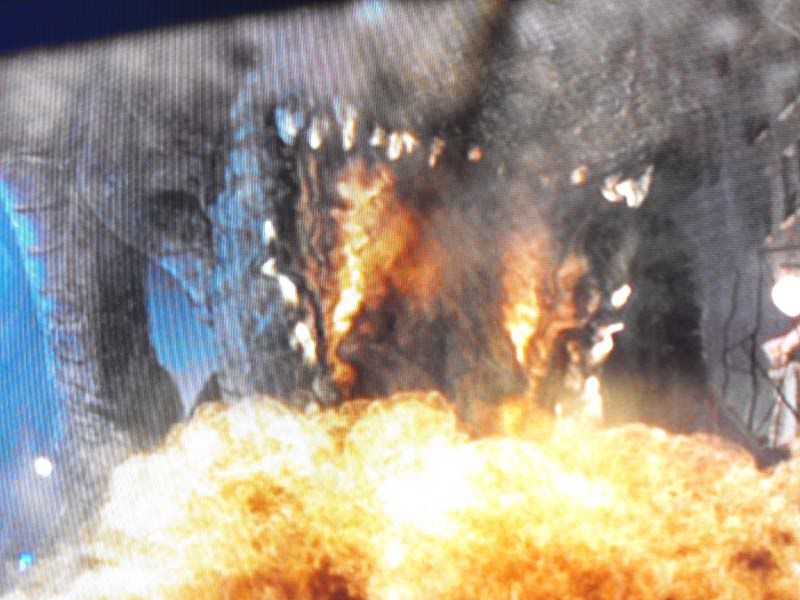
While this version of Godzilla is often criticized by fans of the original series for lacking any special offensive mechanism, it should be noted that Godzilla makes effective use of its claws, teeth, and even its jagged dorsal spines to slash and hack at enemies. Combined with Godzilla’s unparalleled speed and coordination, Godzilla has the potential to be deadly, even against another monster.
Godzilla’s most bizarre addition to its list of abilities would be what the producers dubbed its “power puff breath.” Godzilla can exhale powerful blasts of air, carrying a volatile gas. Should a spark be provided to ignite it, Godzilla’s “power puff breath” can generate massive walls of flame.
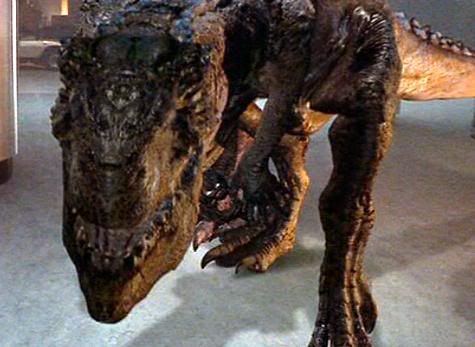 Godzilla was extremely prolific. Requiring no additional member of its species to reproduce, Godzilla laid a clutch of more than two hundred eggs inside Madison Square Garden. Infants of Godzilla’s species were capable of fending for themselves since hatching, and, as it was soon discovered, hunting. Infant Godzillas didn’t have the developed mind that their adult counterpart had and would target food based solely off of a scent. It was later found that they would also base family by scent as well. The monsters were quite fast, and weren’t frightened of machine gun fire. Each individual measured at around nine to eleven foot in height upon birth.
Godzilla was extremely prolific. Requiring no additional member of its species to reproduce, Godzilla laid a clutch of more than two hundred eggs inside Madison Square Garden. Infants of Godzilla’s species were capable of fending for themselves since hatching, and, as it was soon discovered, hunting. Infant Godzillas didn’t have the developed mind that their adult counterpart had and would target food based solely off of a scent. It was later found that they would also base family by scent as well. The monsters were quite fast, and weren’t frightened of machine gun fire. Each individual measured at around nine to eleven foot in height upon birth.
Godzilla: the Series
After Godzilla was at last killed, a 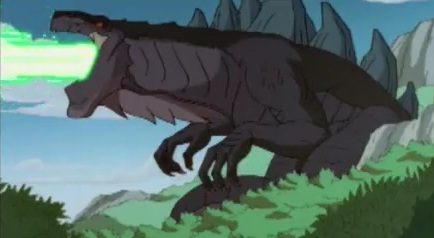 search party was sent back to the creature’s nest in the ruins of Madison Square Garden to search for and destroy any surviving reptiles. During the expedition, Dr. Niko Tatopoulos became separated from his party, and stumbled upon the sole survivor. Nick had fallen into residue left over from the eggs, which masked his scent. The last surviving Godzilla recognized him as family based off of that smell, and imprinted onto Nick as a father figure.
search party was sent back to the creature’s nest in the ruins of Madison Square Garden to search for and destroy any surviving reptiles. During the expedition, Dr. Niko Tatopoulos became separated from his party, and stumbled upon the sole survivor. Nick had fallen into residue left over from the eggs, which masked his scent. The last surviving Godzilla recognized him as family based off of that smell, and imprinted onto Nick as a father figure.
The creature escaped their initial encounter, using its efficient burrowing ability to dig away. Nick collected a group of trusted scientists, Elsie Chapman, Mendel Craven, and Randy Herrandez, to capture the creature without anyone’s knowledge. Together they captured the monster, now a thirty foot gargantuan well on its way to becoming the titan it was meant to be. The team studied the new Godzilla for a period of time, and Nick was impressed as to the creature’s loyalty. It was also found that the monster was infertile.
However, it couldn’t last. The secret was leaked, and the juvenile Godzilla was bombed and apparently killed by fighter jets, it’s body never recovered from the waters. All the while, reports of new creature attacks were being recorded in Jamaica. Niko Tatopoulos and the Godzilla team, with the addition of Monique Dupre of the French Secret Service traveled to Jamaica to investigate, where they were met with the monster Crustaceous Rex. Godzilla resurfaced, now the full sixty meters, and met C-Rex in combat. Godzilla defeated C-Rex, and since then the crew named their team H.E.A.T. They, with the aid of Godzilla, resolved to investigate and deal with the mutations that would come. The second Godzilla never met his end.
The new Godzilla was every bit as fast, efficient and coordinated as its predecessor. However, Godzilla’s intelligence surpassed that of its ancestor, and could withstand more damage. In addition, Godzilla could expel a stream of searing green flame from its mouth, which would almost always finish off an opposing monster.
Godzilla: Final Wars
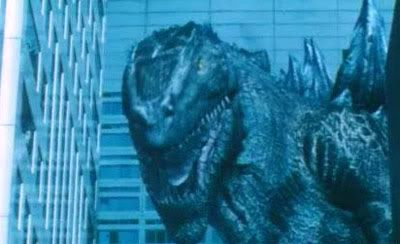 In the 2004 film Godzilla: Final Wars, the earth is up to its ears in monsters when over 11 monsters appear simultaneously to attack major cities across the globe. Among them is a monster named “Zilla” baring a strong resemblance to the version of Godzilla seen in the American made remake. This time the monster is only a sub villain, attacking Sydney, Australia.
In the 2004 film Godzilla: Final Wars, the earth is up to its ears in monsters when over 11 monsters appear simultaneously to attack major cities across the globe. Among them is a monster named “Zilla” baring a strong resemblance to the version of Godzilla seen in the American made remake. This time the monster is only a sub villain, attacking Sydney, Australia.
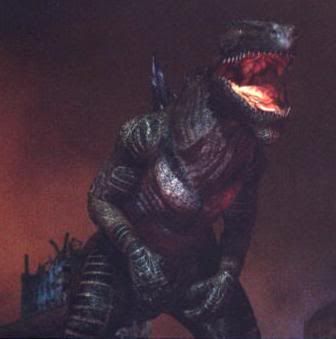 Reportedly, the inclusion of this monster, (done all CGI as opposed to the creature suits used in the rest of the film) was done as an inside joke. It was meant to demonstrate the dominance of the Japanese Godzilla over his American counterpart, and to demonstrate the use of creature suits in giant monster movies, as opposed to computer generated imagery. Ryuhei Kitamura was quoted as explaining the creature’s name saying that the remake “took the God out of Godzilla.”
Reportedly, the inclusion of this monster, (done all CGI as opposed to the creature suits used in the rest of the film) was done as an inside joke. It was meant to demonstrate the dominance of the Japanese Godzilla over his American counterpart, and to demonstrate the use of creature suits in giant monster movies, as opposed to computer generated imagery. Ryuhei Kitamura was quoted as explaining the creature’s name saying that the remake “took the God out of Godzilla.”
While “Zilla’s” inclusion was meant as an insult, I think there was more to it than that. During the initial monster attack Zilla, second only to Rodan’s New York City romp, seems to get the most screen time before Ebirah’s attack. Secondly, Zilla was beautifully crafted in CGI while the other CGI monsters (inter cut with their respective creature suits) seemed to be of slightly lesser quality. Thirdly, Zilla’s inclusion is simply astounding. If you think about it, Godzilla: Final Wars is one of the few movies to feature two incarnations of the same character in one film. After the Godzilla sequel was scrapped, I doubt any had planned to see the monster included in another live-action film (at least not through use of new special effects footage). Also, it should be noted, that the city the creature attacks, Sydney, was reportedly planned to have been the setting for the Godzilla sequel.
Of course, there are still a few differences. Zilla has a slightly different shape to his head, its dewlap is less prominent, the creature is of a lighter skin color, and of course, Godzilla’s signature roar has been replaced. Zilla also boasts a stature of 90 meters, far larger than the 1998 Godzilla’s 60. Finally, unlike the ‘98 Godzilla which merely blew flammable gas, the director reported that Zilla did in fact have a breath weapon, an acid it projected from its stomach which ignited upon contact with the air (seen in the movie from only off screen).
Ultimately, whether you loved, liked, or hated the 1998 Godzilla, the monster’s inclusion in the movie was a joy to behold.